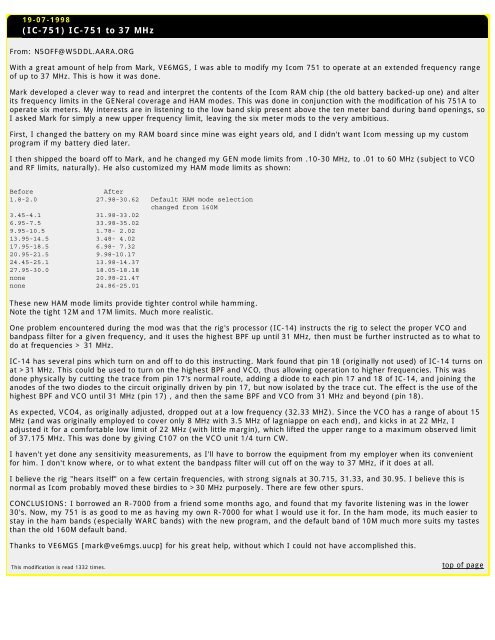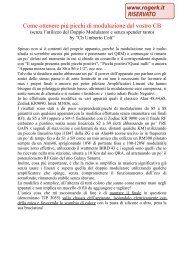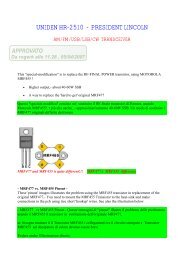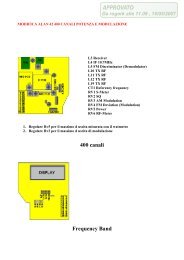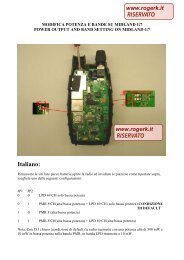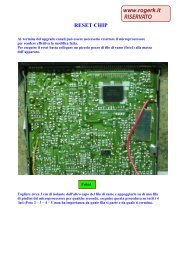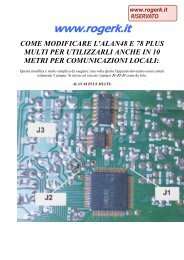Modifications for the ICOM - RogerK
Modifications for the ICOM - RogerK
Modifications for the ICOM - RogerK
- No tags were found...
You also want an ePaper? Increase the reach of your titles
YUMPU automatically turns print PDFs into web optimized ePapers that Google loves.
19-07-1998(IC-751) IC-751 to 37 MHzFrom: N5OFF@W5DDL.AARA.ORGWith a great amount of help from Mark, VE6MGS, I was able to modify my Icom 751 to operate at an extended frequency rangeof up to 37 MHz. This is how it was done.Mark developed a clever way to read and interpret <strong>the</strong> contents of <strong>the</strong> Icom RAM chip (<strong>the</strong> old battery backed-up one) and alterits frequency limits in <strong>the</strong> GENeral coverage and HAM modes. This was done in conjunction with <strong>the</strong> modification of his 751A tooperate six meters. My interests are in listening to <strong>the</strong> low band skip present above <strong>the</strong> ten meter band during band openings, soI asked Mark <strong>for</strong> simply a new upper frequency limit, leaving <strong>the</strong> six meter mods to <strong>the</strong> very ambitious.First, I changed <strong>the</strong> battery on my RAM board since mine was eight years old, and I didn't want Icom messing up my customprogram if my battery died later.I <strong>the</strong>n shipped <strong>the</strong> board off to Mark, and he changed my GEN mode limits from .10-30 MHz, to .01 to 60 MHz (subject to VCOand RF limits, naturally). He also customized my HAM mode limits as shown:Be<strong>for</strong>eAfter1.8-2.0 27.98-30.62 Default HAM mode selectionchanged from 160M3.45-4.1 31.98-33.026.95-7.5 33.98-35.029.95-10.5 1.78- 2.0213.95-14.5 3.48- 4.0217.95-18.5 6.98- 7.3220.95-21.5 9.98-10.1724.45-25.1 13.98-14.3727.95-30.0 18.05-18.18none 20.98-21.47none 24.86-25.01These new HAM mode limits provide tighter control while hamming.Note <strong>the</strong> tight 12M and 17M limits. Much more realistic.One problem encountered during <strong>the</strong> mod was that <strong>the</strong> rig's processor (IC-14) instructs <strong>the</strong> rig to select <strong>the</strong> proper VCO andbandpass filter <strong>for</strong> a given frequency, and it uses <strong>the</strong> highest BPF up until 31 MHz, <strong>the</strong>n must be fur<strong>the</strong>r instructed as to what todo at frequencies > 31 MHz.IC-14 has several pins which turn on and off to do this instructing. Mark found that pin 18 (originally not used) of IC-14 turns onat >31 MHz. This could be used to turn on <strong>the</strong> highest BPF and VCO, thus allowing operation to higher frequencies. This wasdone physically by cutting <strong>the</strong> trace from pin 17's normal route, adding a diode to each pin 17 and 18 of IC-14, and joining <strong>the</strong>anodes of <strong>the</strong> two diodes to <strong>the</strong> circuit originally driven by pin 17, but now isolated by <strong>the</strong> trace cut. The effect is <strong>the</strong> use of <strong>the</strong>highest BPF and VCO until 31 MHz (pin 17) , and <strong>the</strong>n <strong>the</strong> same BPF and VCO from 31 MHz and beyond (pin 18).As expected, VCO4, as originally adjusted, dropped out at a low frequency (32.33 MHZ). Since <strong>the</strong> VCO has a range of about 15MHz (and was originally employed to cover only 8 MHz with 3.5 MHz of lagniappe on each end), and kicks in at 22 MHz, Iadjusted it <strong>for</strong> a com<strong>for</strong>table low limit of 22 MHz (with little margin), which lifted <strong>the</strong> upper range to a maximum observed limitof 37.175 MHz. This was done by giving C107 on <strong>the</strong> VCO unit 1/4 turn CW.I haven't yet done any sensitivity measurements, as I'll have to borrow <strong>the</strong> equipment from my employer when its convenient<strong>for</strong> him. I don't know where, or to what extent <strong>the</strong> bandpass filter will cut off on <strong>the</strong> way to 37 MHz, if it does at all.I believe <strong>the</strong> rig "hears itself" on a few certain frequencies, with strong signals at 30.715, 31.33, and 30.95. I believe this isnormal as Icom probably moved <strong>the</strong>se birdies to >30 MHz purposely. There are few o<strong>the</strong>r spurs.CONCLUSIONS: I borrowed an R-7000 from a friend some months ago, and found that my favorite listening was in <strong>the</strong> lower30's. Now, my 751 is as good to me as having my own R-7000 <strong>for</strong> what I would use it <strong>for</strong>. In <strong>the</strong> ham mode, its much easier tostay in <strong>the</strong> ham bands (especially WARC bands) with <strong>the</strong> new program, and <strong>the</strong> default band of 10M much more suits my tastesthan <strong>the</strong> old 160M default band.Thanks to VE6MGS [mark@ve6mgs.uucp] <strong>for</strong> his great help, without which I could not have accomplished this.This modification is read 1332 times.top of page


